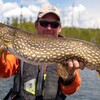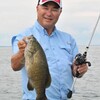
Five Tournament Tactics

1. A FAST LIMIT OR FIVE BIG BITES

The age-old question in tournament fishing is whether to try for a quick limit before going for bigger fish or to target five big bites over the course of the day. It’s great to catch a load of fish, but is it worth it?
Whether to go for a quick limit or for 5 big bites all depends on the place you’re fishing. If historically—and this is why you really have to know a little bit about the body of water you’re fishing—it takes 18 or 20 pounds a day to win on a particular lake, a limit of keeper-sized fish won’t get you a cheque at the end of the day. Here in Ontario, whether you’re fishing a tournament in Kenora or Cornwall, the fact is that a limit of keeper fish generally won’t do much for you.
Many of the tournaments I fish in the US are low-weight tournaments, and if you can get a limit you’re doing phenomenally well because maybe only a third or a quarter of the field might have five bass in a day. The strategy there is to try and get as many bites as you can.
Having said that, going for five big bites is not as easy as it might sound. I’ll give you an example. A number of years ago during day two of our Pro Bass Classic on Rice Lake, I was fishing a small rock hump for over an hour and hadn’t caught a fish. I was getting a little impatient, so I decided to make a couple more casts and I then I’d leave. Wouldn’t you know it, I caught one around 4 pounds. At that point, I said okay, maybe I should fish here a little bit longer. So I ended up fishing for another 45 minutes and I got another good one of around 4 pounds. Every 45 minutes to an hour I’d get one big fish. I ended up getting six fish off that spot and had the second-biggest limit in that tournament.
I went back to the same spot on day three and I didn’t catch a fish. That’s what can happen when you go for five big bites. You’re definitely gambling more than if you went after a limit first. There’s really no right or wrong answer to the question of whether to go for a limit or to concentrate on catching only big fish. It all depends on which approach you’re most comfortable with, and the quality of the fishery.
2. TARGETING BIG FISH

How exactly do you target big fish? Everyone who has fished for any length of time has probably caught a couple of exceptional fish, but what does it take to catch them consistently?
This depends on whether you’re fishing largemouth or smallmouth, but let’s use a couple of examples. Take smallmouth, for instance. Many times, smallmouth bass will group according to size or year class. If you’re in a spot where you’re catching lots of 1- to 2-pounders, chances are there are very few or no big fish there. On the other hand, if you get a big smallmouth, chances are there are some more of that same-year class in that area. This grouping of fish by size doesn’t happen all the time, but it is definitely worth keeping in mind when you’re looking for a big-kicker fish.
To find big largemouth, one place to look is in the heaviest, thickest, gnarliest cover you can find. These types of areas call for pitching and flipping tactics with jigs and Texas-rigged soft baits. You might get some smaller fish out on the edges of a weed line, whereas if you moved deeper into that weed bed, into where it mats up and nobody ventures (except other tournament anglers), you are more likely to find bigger fish.
3. RUNNING AND GUNNING OR SPOT SITTING

Patience, it has been said, is a virtue, but does patience cut it when you’ve only got eight hours to catch five big fish? Is it better to sit in a known fish-holding area and wait for the fish to show up, or should you go looking for them?
Running and gunning versus hole sitting has always been a great debate among tournament anglers. Some tournament anglers are programmed for “junk fishing,” which is a term used by tournament anglers who carry 10 to 20 rods on the deck of the boat, all rigged with different baits and line tests and rod actions for all different techniques. These guys are flippin’, crankin’, spinnerbaits, buzzing—they’re doing a number of things throughout the day and in most cases, they’re covering lots of water.
You have to keep in mind that running and gunning don’t mean fishing a spot fast. It involves fishing a lot of spots efficiently, meaning you’re putting your casts right where they should be. You’re not working up and down the break, you’re not working along a contour line—you’re fishing exact areas like a rock pile, a log, that sort of thing. The spots are so small and precise, they only require maybe three to 30 casts to cover them. If you’re running and gunning, you don’t have time to prospect a contour or weed line for 200 yards.
I follow the US tournaments very closely, and about half of them are won in an area—not necessarily hole sitting, but working an area. You could call it quasi-hole sitting. The other half, or maybe a little more, are won by guys who are running patterns. Running and gunning doesn’t necessarily mean running a pattern, it could be just junk fishing. So there’s working an area, there’s running a pattern—which could be running and gunning or not—and there’s junk fishing, so you’ve really got three different approaches. It’s pretty interesting, and there will always be debate about which is better.
Personally, I find hole-sitting to be dreadfully boring; it does not fit my personality. I like to move around during the day. As I said, it doesn’t always pay off, but I don’t get bored that way. When the guy who hole-sat or fished an area—and didn’t burn more than two gallons of gas all day—beats me in a tournament, I’m sure he gets a lot of satisfaction from going home with a giant cheque. There are always two sides to the story.
4. SHALLOW OR DEEP
On any given day, there will be fish caught from a variety of areas on a range of baits and techniques. Is it more productive to target shallow fish or those in deeper water?
I prefer shallow fishing because I like to see the fish before they see my bait. To me, it’s so much more consistent when you can see the fish and you can work on it. It’s easy in the spawning or post-spawn seasons, but when you see a shallow fish later on in the season, you’ve got to try and determine its mood and try to figure out what to do to make it bite. I look at everything from the fish’s fin movements to its eyes. I just watch the way that fish is moving, its behaviour, how it’s swimming—there are all sorts of things you can pick up on if you pay attention.
Every fish tells a story and each time you catch a fish you should analyze everything about it: the angle at your bait was worked, whether you were casting into the wind or with the wind if the sun was behind you or in your face, where the fish was positioned, and so on. Even the fish’s reaction to being hooked can be a tip. Did it swim out towards deeper water when it hit your bait, or did it grab your bait and go back into the cover? If the fish swims out from cover, into open water, there’s a good chance that there are more fish in that spot, and the one you hooked is trying to get away from them. If the fish digs deeper into the cover, the odds are good that it was only the one in there.
5. LARGEMOUTH OR SMALLMOUTH

Many lakes in Ontario hold good populations of both largemouth and smallmouth bass, and tournament anglers have to decide which species to target. In the case of a multi-species bass fishery, which would you concentrate on?
I think both smallmouth and largemouth can be caught easily if they’re active, and I think both of them can be equally hard too. The conditions will dictate whether you’re going to catch easy fish, or you’re really going to have to scrape and work for them. I think that if the smallmouth is really active and turned on, they are probably a little bit more suicidal than the largemouth. But when largemouth are put in the feedbag, they can be pretty wild too.
Years ago, I would have said that smallmouth was easier to catch early in the morning or late in the afternoon. Nowadays it seems like many of the big waters, like lakes Simcoe, Ontario, or Erie, get better for smallmouth later in the day. My theory is that a lot of the deep water fish move shallower to digest bait and start to show themselves around mid-day or later. On smaller lakes, I’ve seen the opposite— the smallmouth are most active in the morning and evening, but harder to catch during the day.
Recommended Articles

20 Years With Fish TV!

10 Facts About Lake of the Woods

Eating Northern Pike

Chiblow Lake Smallmouth Adventures

Choose your Fishing Adventure: 39 Lodges Accessible by Train, Plane, Boat, and Automobile in Ontario
Ontario Brook Trout
Top 5 Musky Destinations in Ontario

Weather or Not

3 Great Ontario Walleye Destinations

Structure or Cover?

Pleasant Cove Resort

Shoreline Strategies

Lodge 88: Keeping it in the Family

Casting for Coasters
Don’t Be Afraid Of Muskies

Top Flies for Northern Pike

Bronze Bass Blast

Guided Fishing on Lake St. Clair

Ten Mile Lake Lodge


